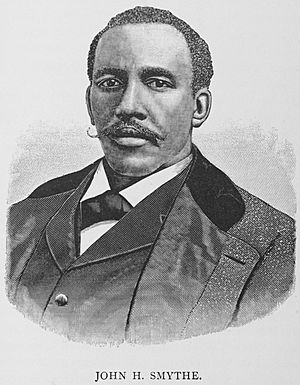John H. Smythe facts for kids
Quick facts for kids
John H. Smythe
|
|
|---|---|

Smythe in 1887
|
|
| United States Minister to Liberia | |
| In office May 23, 1878 – December 22, 1881 |
|
| President | Rutherford B. Hayes James A. Garfield |
| Preceded by | J. Milton Turner |
| Succeeded by | Henry H. Garnet |
| In office April 12, 1882 – December 14, 1885 |
|
| President | Chester A. Arthur Grover Cleveland |
| Preceded by | Henry H. Garnet |
| Succeeded by | Moses A. Hopkins |
| Personal details | |
| Born | July 14, 1844 Richmond, Virginia, U.S. |
| Died | September 5, 1908 (aged 64) Richmond, Virginia, U.S. |
| Political party | Republican |
| Alma mater | Howard University |
| Occupation | Politician, educator |
John H. Smythe (born July 14, 1844 – died September 5, 1908) was an important American diplomat. He served as the U.S. Minister to Liberia twice. His first term was from 1878 to 1881, and his second was from 1882 to 1885. Before becoming a diplomat, he worked in different government jobs. Later in his life, he was involved in many important African American groups. He also led a school for young people in Richmond, Virginia.
Contents
Early Life and Education
John H. Smythe was born in Richmond, Virginia, on July 14, 1844. His parents were Sully and Ann Eliza Smythe. John learned to read when he was very young.
Around age eight, he moved to Philadelphia, Pennsylvania, for school. He first went to a Quaker school. Then he attended a grammar school. When his father passed away, John left school for a year to work. He was an errand boy in a store.
In 1859, he went back to school. He enrolled at the Institute for Colored Youth. This school was run by Quakers. He graduated on May 4, 1862. John was also a talented painter. He became a member of the Pennsylvania Academy of the Fine Arts. He liked to paint landscapes.
After graduating, in 1864, he worked in a china house. He also worked briefly for the United States Army during the American Civil War (1861–1865).
Career Highlights
Starting in Government Work
In 1865, Smythe traveled to London. He wanted to learn acting. But he ran out of money and returned home. He then became a teacher in Wilkes-Barre, Pennsylvania.
In 1869, Smythe began studying law at Howard University. While he was a student, he started working for the government. He became a clerk in the Freedmen's Bureau in 1870. He later worked for the United States Census. In 1872, he became a clerk in the United States Department of the Treasury.
He then worked at the Freedman's Savings Bank in Washington, D.C. Soon after, he moved to Wilmington, North Carolina. There, he worked as a cashier for the bank. When the bank closed, Smythe stayed in Wilmington. He passed the North Carolina Bar exam and became a lawyer.
Diplomat in Liberia
In Wilmington, Smythe was active in politics. He was part of the State Constitutional Convention in 1875. He supported the Republican Party. He helped with the presidential campaigns of Ulysses S. Grant and Rutherford B. Hayes.
In 1878, Smythe was recommended for a special job. He was chosen to be the U.S. Minister to Liberia. This was a very important role. Frederick Douglass and Blanche K. Bruce also supported his appointment. He started this job on May 23, 1878.
President James A. Garfield recalled him for a short time. But President Chester A. Arthur reappointed him on April 12, 1882. During his time in Liberia, he also managed the German and Belgian Consulates. He even represented the King of Norway and Sweden. Smythe hired local people for consul jobs in Africa. This helped create good relationships between the U.S. and West African nations.
He received an honorary law degree from Liberia College. The Liberian president also honored him. He was made a knight commander of the Liberian Humane Order of African Redemption. President Grover Cleveland recalled him in 1885. Smythe then returned to Washington D.C. to practice law.
Community Involvement
John H. Smythe was a leader in many African American organizations. In 1877, he helped form the Negro American Society. This group later became the American Negro Academy.
He also helped start the Virginia Manual Labor School in 1897. This school aimed to help young people. In 1898, Smythe attended meetings to form the Afro-American Council. However, he disagreed with some of their ideas. He did not support mixed schools or marriages. So, he left the group.
Smythe was also a member of the London Atheneum Club. He was a key member of the Grand Fountain of the United Order of True Reformers. This was a civic group in Richmond. He was the editor of their newspaper, The Reformer. In 1903, Smythe started a company. It aimed to raise money for a black exhibit at the 1907 Jamestown Exposition.
Personal Life and Legacy
John H. Smythe was a Presbyterian. He married Fannie Shappen and they had children. He passed away in Richmond, Virginia, on September 5, 1908. He died at his daughter's home. His daughter was Dr. Clara H. Smythe.
An elementary school for black children in Norfolk, Virginia, was named after him.
His grandson, John Henry Clavell Smythe, was also a notable person. He was a flight navigator in World War II. He later became a lawyer and Attorney-General in Sierra Leone.

